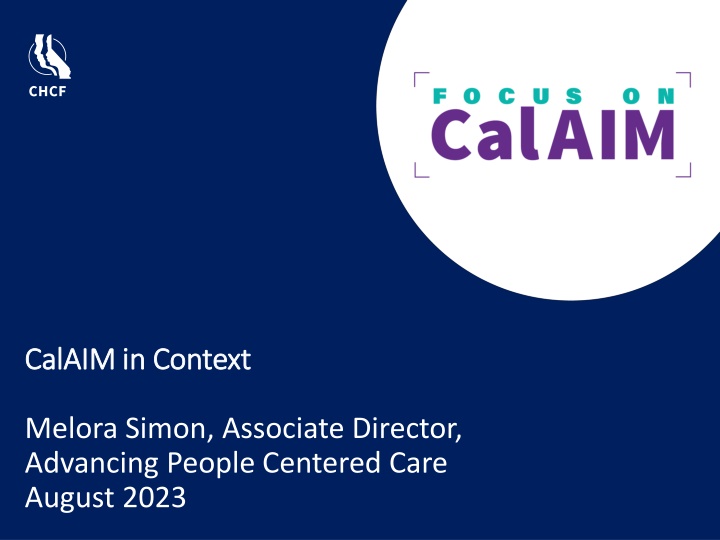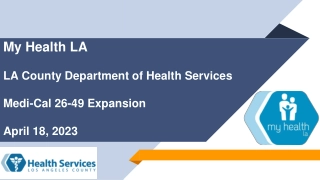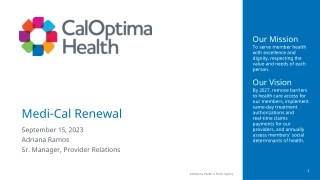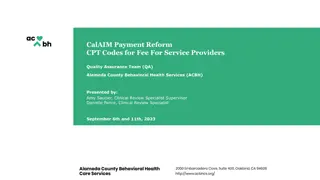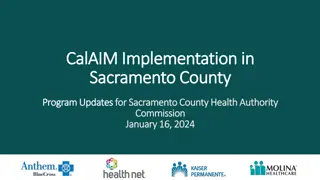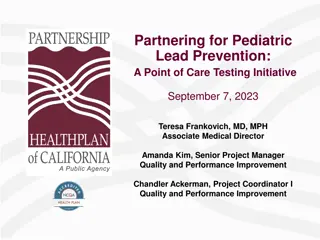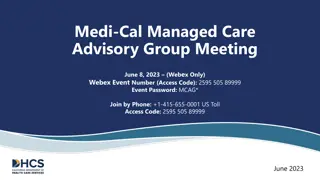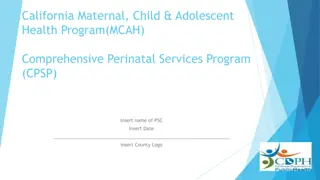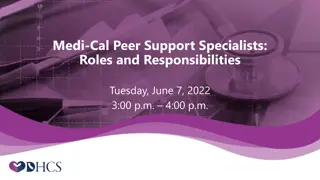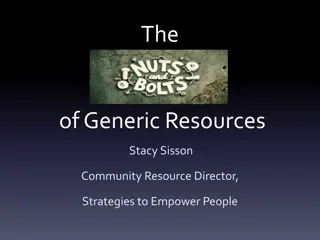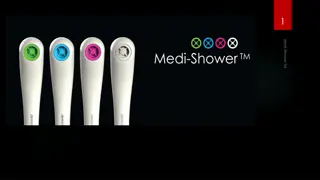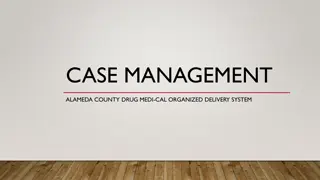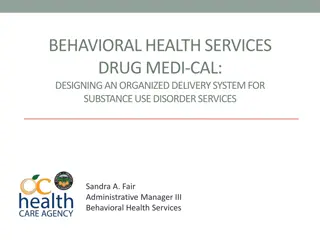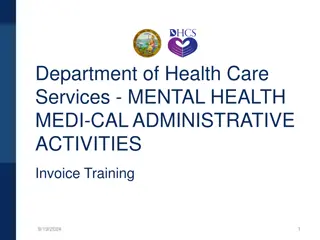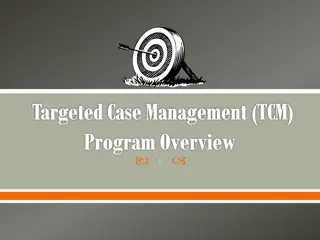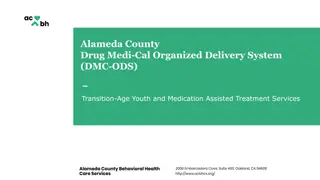Challenges in Navigating the Medi-Cal System - Insights and Experiences
Medi-Cal coverage in California is comprehensive but complex to navigate, leading to difficulties in accessing needed care, especially for individuals with complex needs. The system includes mental health plans, managed care options, Medicare, and substance use services. Coordination challenges and delays in receiving care are highlighted, with patient experiences in Medi-Cal managed care ranking low nationally. Insights from Californians with low incomes emphasize the struggles faced in accessing comprehensive care services.
Download Presentation

Please find below an Image/Link to download the presentation.
The content on the website is provided AS IS for your information and personal use only. It may not be sold, licensed, or shared on other websites without obtaining consent from the author.If you encounter any issues during the download, it is possible that the publisher has removed the file from their server.
You are allowed to download the files provided on this website for personal or commercial use, subject to the condition that they are used lawfully. All files are the property of their respective owners.
The content on the website is provided AS IS for your information and personal use only. It may not be sold, licensed, or shared on other websites without obtaining consent from the author.
E N D
Presentation Transcript
CalAIM in Context CalAIM in Context Melora Simon, Associate Director, Advancing People Centered Care August 2023
Agenda Agenda CalAIM in Context: The Medi-Cal System CalAIM Overview CalAIM Experiences to date California Health Care Foundation California Health Care Foundation www.chcf.org www.chcf.org
Medi Medi- -Cal coverage is comprehensive, but it is a complex system to navigate Cal coverage is comprehensive, but it is a complex system to navigate Mental Health Plans (counties) Managed Care Plans Medicare State Fee-for-Service System Substance Use Services (counties) Option to receive through managed care plan Moves to managed care Who Medi-Cal covers: 1/3 of Californians of school age children and births of people with disabilities 2/3 of LTC days Prescription Drugs Dental Care Non-Specialty Mental Health Care Help at Home: In Home Supportive Services Physical Health Care Specialty Mental Health Care Substance Use Services* Home and Community Based Services Waiver Programs California Children s Services* Long-Term Care in Nursing Homes* (2023) Adult Day Health Services CalAIM moved Long-Term Care to managed care and requires managed care to coordinate across services * Varies by county; By 2027, Mental Health and Substance Use Services will undergo administrative integration statewide. California Health Care Foundation California Health Care Foundation www.chcf.org www.chcf.org
People have difficulty getting what they need in the Medi People have difficulty getting what they need in the Medi- -Cal system Cal system Medi-Cal managed care performs in the bottom quartile nationally for patient experience of access to care Getting Care Quickly Getting Needed Care 1 in 4 say sometimes or never 1 in 4 say sometimes or never Source: 2019 California CAHPS Survey Summary Report for Medicaid Managed Care. California Health Care Foundation California Health Care Foundation www.chcf.org www.chcf.org
Access and coordination challenges are marked for people with complex Access and coordination challenges are marked for people with complex needs needs Hard to get needed care in a timely way I want to go into rehab. And they say, Okay, well call this number. Then you call the number and they say, Okay, well, I can see you in two weeks. What am I supposed to do? Keep drinking? I want to stop now. Listening to Californians with Low Incomes Hard to get whole-person care I have to wonder if my primary doctor and my mental heath doctor if they communicated better, if there would be something that would guide me in better wellness. Listening to Californians with Low Incomes California Health Care Foundation California Health Care Foundation www.chcf.org www.chcf.org
On quality, Medi On quality, Medi- -Cal performs well overall, but falls below national benchmarks Cal performs well overall, but falls below national benchmarks on measures that require coordination during transitions or handoffs on measures that require coordination during transitions or handoffs Medi-Cal falls below national benchmarks in population health measures. % receiving recommended care, All Medi-Cal enrollees % getting recommended care Gap to National Median SUD follow-up within 7 days of ED visit 7.6% 7.6% Developmental Screening in the first 3 years 13.4% 22.2% Initiation of SUD treatment within 14 days of diagnosis 7.6% 35.1% Well Child Visits in the first 15 months 11.0% 54.6% Diabetes screening for people on antipsychotic medications 3.2% 77.1% Source: 2020 Child and Adult Health Care Quality Measures Quality accessed at https://data.medicaid.gov/dataset/fbbe1734-b448-4e5a-bc94-3f8688534741 on February 16; California Health Care Foundation California Health Care Foundation www.chcf.org www.chcf.org
Medi Medi- -Cal is also not immune to significant racial and ethnic inequities Cal is also not immune to significant racial and ethnic inequities Quality of mental health care: Only 36.5% of Black adults diagnosed with major depression and started on an antidepressant remained on it for 180 days, compared to almost 50% of their white counterparts. Childhood prevention: Only 22% of Black children are fully immunized at the age of two, compared to 40% statewide. Chronic disease care: Almost half of Black and Native American people with diabetes live with poorly controlled blood sugar, compared to 41% statewide. The more you advocate about your own health, the more issues get addressed. And if you re not an advocate, sometimes you can be left kind of on the sidelines. Listening to Black Californians Source: 2020 Health Disparities Report, Department of Health Care Services, December 2021. California Health Care Foundation California Health Care Foundation www.chcf.org www.chcf.org
Millions of people with Medi Millions of people with Medi- -Cal coverage have complex needs Cal coverage have complex needs CalAIM has specific reforms for many of these populations of focus specific reforms for many of these populations of focus CalAIM has ILLUSTRATIVE SCALE DEGREE OF OVERLAP LARGELY UNKNOWN 2.2 million seniors and people with disabilities 1.6 million who are dually eligible for Medi-Cal and Medicare ~50,000 who are in institutions but could thrive in the community 270,000 children/youth in California Children s Services and/or the Health Care Program for Children in Foster Care 350,000people transitioning from incarceration with a behavioral health diagnosis 650,000 people in county behavioral health systems 125,000 people experiencing homelessness and have a disabling condition Source: Medi-Cal enrolled seniors and persons with disabilities and those dually eligible for Medi-Cal and Medicare, September 2021, Medi-Cal Fast Facts (PDF); People accessing homeless services in 2019 with a disabling condition, Homeless Data Integration System; Medi-Cal enrollees served in Specialty Mental Health System, FY 18 19; Adults (PDF) and Youth (PDF). People treated in public substance use disorder system, FY 17 18; Substance Use Almanac, CHCF; People in Jails with a mental health condition, The Prevalence of Mental Illness in California Jails is Rising: An Analysis of Mental Health Cases & Psychotropic Medication Prescriptions, 2009-2019; California Health Policy Strategies (PDF); Prison population with substance use disorder and/or mental health concerns, 2011; RAND. 2012. Understanding the Public Health Implications of Prisoner Reentry in California. (PDF); California Children s Services Population from CCS Advisory Group Discussion (PDF), April 2021 and Children in Foster Care from Kids Data. California Health Care Foundation California Health Care Foundation www.chcf.org www.chcf.org
Agenda Agenda CalAIM in Context: The Medi-Cal System CalAIM Overview CalAIM Experiences to date California Health Care Foundation California Health Care Foundation www.chcf.org www.chcf.org
CalAIMs CalAIM s Promise: Raising the bar for all Promise: Raising the bar for all Narrowing the gap in payment rates: Increasing provider payment rates for primary care, behavioral health care, and obstetric services Strengthening incentives: Incorporating performance on access, quality and equity into how managed care plans are paid Leveling managed care playing field: Consistent population health management approach alongside standardization of managed care enrollment and benefits that will enable apples-to-apples comparison Increasing managed care oversight: Application of uniform sanctions, expanded oversight of timely access across delivery systems, and transparency around medical spending including delegated entities California Health Care Foundation California Health Care Foundation www.chcf.org www.chcf.org
CalAIMs CalAIM s Promise: Better care for people with complex needs Promise: Better care for people with complex needs Enhanced Care Management to provide intensive coordination of health and health-related services to engage and support ten populations of focus with the highest level of need Plan incentives to offer Community Supports non-traditional services such as housing navigation, asthma remediation, or wraparound services in an assisted living facility Re-entry support: Selected services in the 90 days prior to release from incarceration Integrated care for people dually eligible for Medicare and Medi-Cal Improved data sharing across systems No Wrong Door suite of policies across behavioral health systems and behavioral health payment reform (movement to a system more like that of the one for physical health) California Health Care Foundation California Health Care Foundation www.chcf.org www.chcf.org
Rosalinds Story Rosalind s Story Diagnosed with bipolar disorder as an adolescent after a suicide attempt Turned to alcohol to self-medicate Became homeless and cycled in and out of the hospital for years Getting housing was the breakthrough Now stable and supported by a team that helps her remember to take her medication and go to the doctor www.chcf.org/dualdiagnosis California Health Care Foundation California Health Care Foundation www.chcf.org www.chcf.org
Agenda Agenda CalAIM in Context: The Medi-Cal System CalAIM Overview CalAIM Experiences to date California Health Care Foundation California Health Care Foundation www.chcf.org www.chcf.org
CHCF CalAIM Learning Goals CHCF CalAIM Learning Goals Explore how CalAIM has improved access to integrated, holistic services for members from the perspective of implementers Find out whether CalAIM has changed the profile of who is getting services, or made it more or less equitable, and gather feedback on other intended or unintended effects of CalAIM Surface bright spots where things are going well, as well as potential solutions where things are not going well CHCF Project Timeline CHCF Project Timeline Phase 1 Focus Groups Spring 2023 Wave 1 Online Survey Summer 2023 We are here Phase 2 Focus Groups Winter 2024 Wave 2 Online Survey Spring 2024 California Health Care Foundation www.chcf.org
Focus Group Approach Focus Group Approach Phase 1 Focus Groups Six online focus groups among 37 CalAIM implementers from March 28 and April 27, 2023. Participants were divided into the following categories for groups. Acute Hospital Discharge Planners (Discharge Planner) Enhanced Care Managers working in primary care - All FQHCs Homeless service providers and Medical Respite/Recuperative care providers Managed Care Plans (MCP) Community Based Organizations providing other community supports - mostly asthma remediation Behavioral Health Leaders - mix of county and county-contracted providers California Health Care Foundation www.chcf.org
Focus Group Findings Focus Group Findings While many are optimistic about the future of While many are optimistic about the future of CalAIM identify a range of roadblocks and challenges identify a range of roadblocks and challenges CalAIM, participants , participants Most are not surprised by the rocky rollout, but participants want CalAIM to start demonstrating real improvements in their work and the lives of their patients. Many are optimistic about CalAIM, and express agreement with CalAIM s goals and objectives. However, participants also express frustration that these goals do not match the reality on the ground and discuss the many challenges they continue to face, such as a lack of standardized processes and different documentation requirements. While some of these challenges are universal, others are unique to individual participants work settings and roles. To that end, they share many recommendations and ideas about how to improve implementation. Despite the challenges that participants discuss, some also discuss a few places where things are going well. However, these bright spots are individual to their fields and professions; some of the organizations have found solutions or ways to make things work, but they may not always be replicable throughout the state. California Health Care Foundation www.chcf.org
Full findings available at: Full findings available at: CalAIM Experiences: Implementer Views After First Year of Reforms. CalAIM Experiences: Implementer Views After First Year of Reforms. California Health Care Foundation California Health Care Foundation www.chcf.org www.chcf.org
